Analysis of R&D Tax Incentives and Their Impact on Small Businesses
VerifiedAdded on 2023/06/12
|10
|2826
|267
Report
AI Summary
This report examines the tax implications of Research and Development (R&D) incentives for small businesses in Australia. It discusses the types of R&D activities that qualify for tax offsets, differentiating between core and supporting activities. The report also outlines the eligibility criteria for businesses to claim R&D tax incentives, including requirements related to incorporation and turnover. It further explains the refundable and non-refundable components of the R&D tax incentive program and the relevant regulations administered by the Australian Tax Office (ATO) and Innovation and Science Australia. The implications of these incentives, including the impact of legislative changes and ongoing reviews, are explored, emphasizing the need for policy certainty to encourage innovation. The report concludes by highlighting the significant role of R&D tax incentives in supporting biotechnology and other industries, while noting the importance of consistent government commitment to ensure the continued success of innovative Australian businesses. Access more solved assignments and study resources on Desklib.
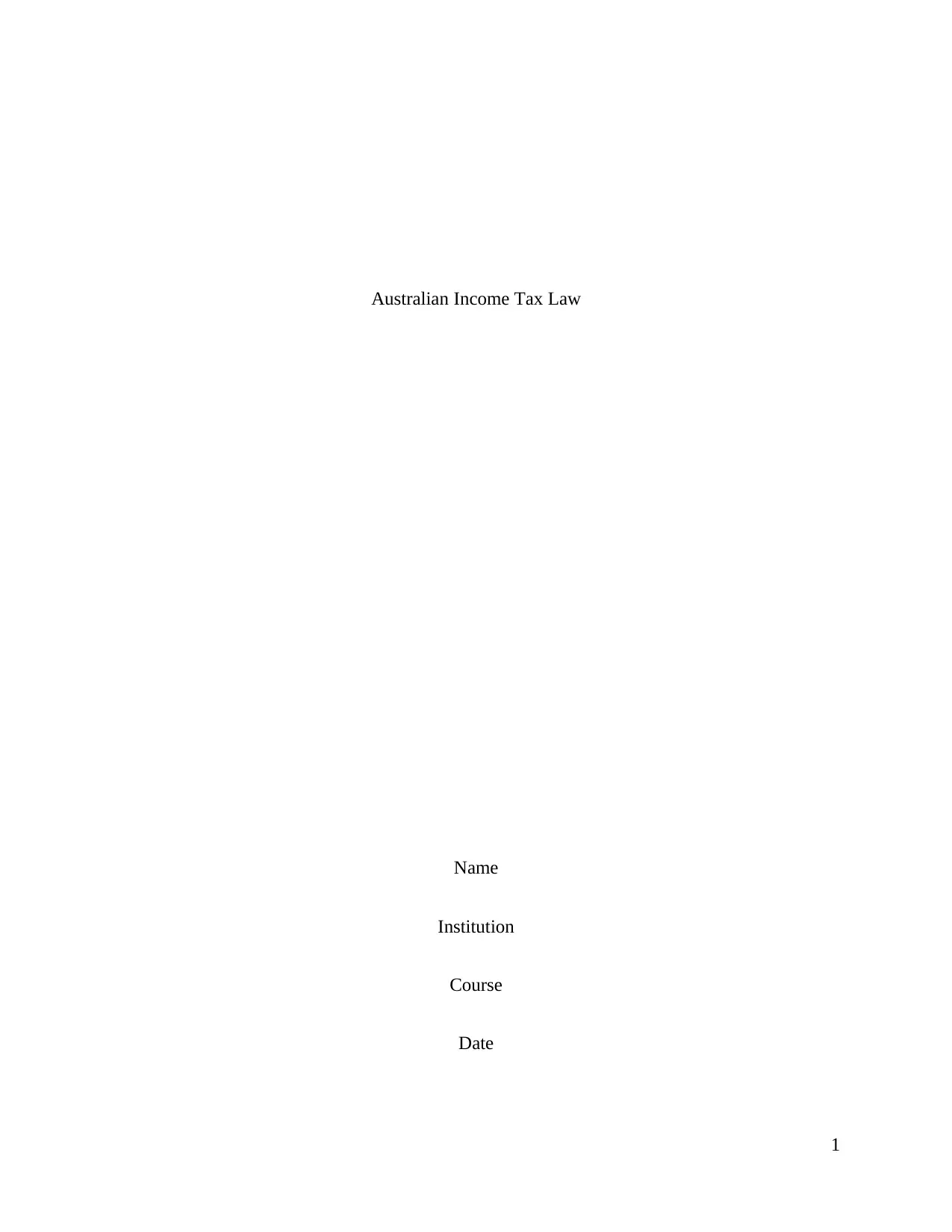
Australian Income Tax Law
Name
Institution
Course
Date
1
Name
Institution
Course
Date
1
Paraphrase This Document
Need a fresh take? Get an instant paraphrase of this document with our AI Paraphraser
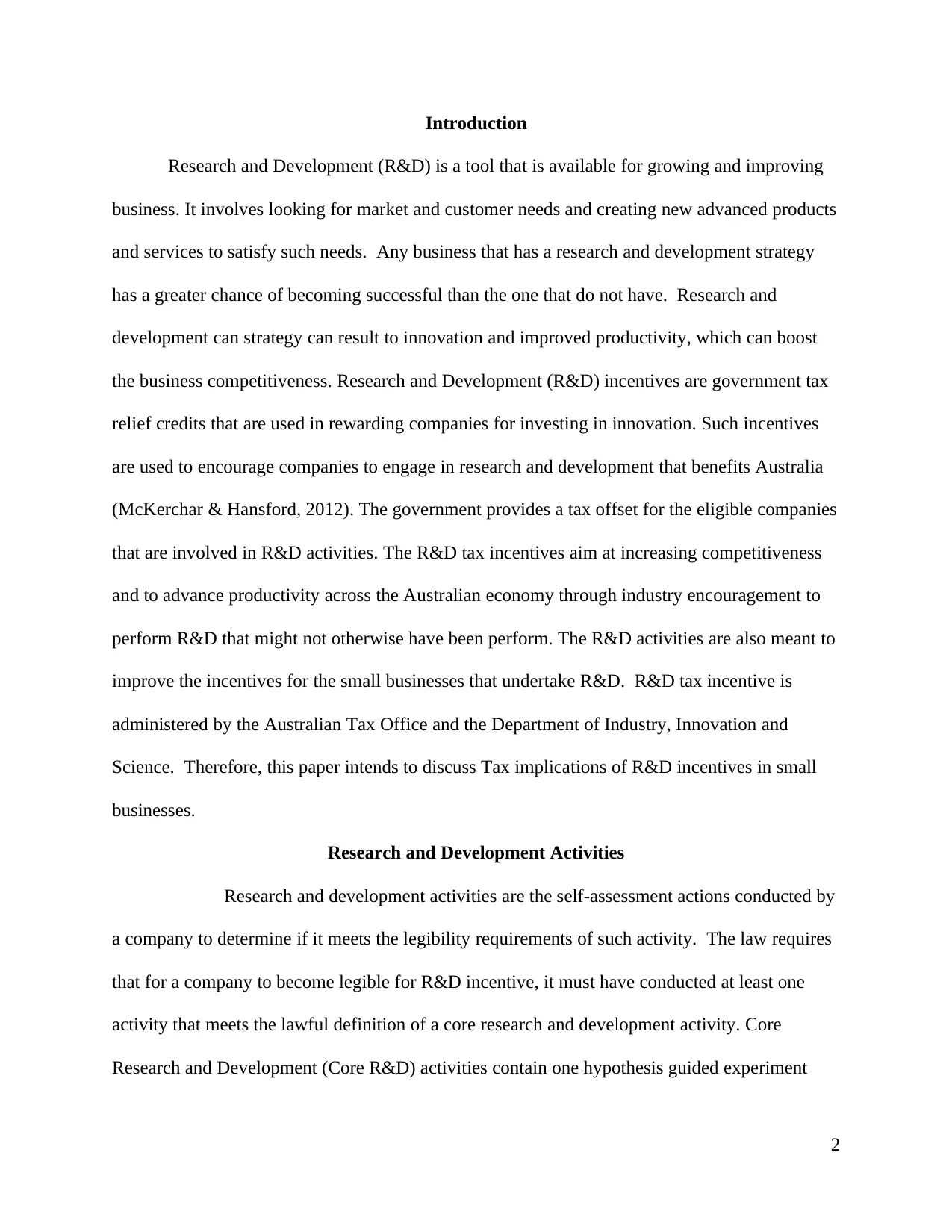
Introduction
Research and Development (R&D) is a tool that is available for growing and improving
business. It involves looking for market and customer needs and creating new advanced products
and services to satisfy such needs. Any business that has a research and development strategy
has a greater chance of becoming successful than the one that do not have. Research and
development can strategy can result to innovation and improved productivity, which can boost
the business competitiveness. Research and Development (R&D) incentives are government tax
relief credits that are used in rewarding companies for investing in innovation. Such incentives
are used to encourage companies to engage in research and development that benefits Australia
(McKerchar & Hansford, 2012). The government provides a tax offset for the eligible companies
that are involved in R&D activities. The R&D tax incentives aim at increasing competitiveness
and to advance productivity across the Australian economy through industry encouragement to
perform R&D that might not otherwise have been perform. The R&D activities are also meant to
improve the incentives for the small businesses that undertake R&D. R&D tax incentive is
administered by the Australian Tax Office and the Department of Industry, Innovation and
Science. Therefore, this paper intends to discuss Tax implications of R&D incentives in small
businesses.
Research and Development Activities
Research and development activities are the self-assessment actions conducted by
a company to determine if it meets the legibility requirements of such activity. The law requires
that for a company to become legible for R&D incentive, it must have conducted at least one
activity that meets the lawful definition of a core research and development activity. Core
Research and Development (Core R&D) activities contain one hypothesis guided experiment
2
Research and Development (R&D) is a tool that is available for growing and improving
business. It involves looking for market and customer needs and creating new advanced products
and services to satisfy such needs. Any business that has a research and development strategy
has a greater chance of becoming successful than the one that do not have. Research and
development can strategy can result to innovation and improved productivity, which can boost
the business competitiveness. Research and Development (R&D) incentives are government tax
relief credits that are used in rewarding companies for investing in innovation. Such incentives
are used to encourage companies to engage in research and development that benefits Australia
(McKerchar & Hansford, 2012). The government provides a tax offset for the eligible companies
that are involved in R&D activities. The R&D tax incentives aim at increasing competitiveness
and to advance productivity across the Australian economy through industry encouragement to
perform R&D that might not otherwise have been perform. The R&D activities are also meant to
improve the incentives for the small businesses that undertake R&D. R&D tax incentive is
administered by the Australian Tax Office and the Department of Industry, Innovation and
Science. Therefore, this paper intends to discuss Tax implications of R&D incentives in small
businesses.
Research and Development Activities
Research and development activities are the self-assessment actions conducted by
a company to determine if it meets the legibility requirements of such activity. The law requires
that for a company to become legible for R&D incentive, it must have conducted at least one
activity that meets the lawful definition of a core research and development activity. Core
Research and Development (Core R&D) activities contain one hypothesis guided experiment
2
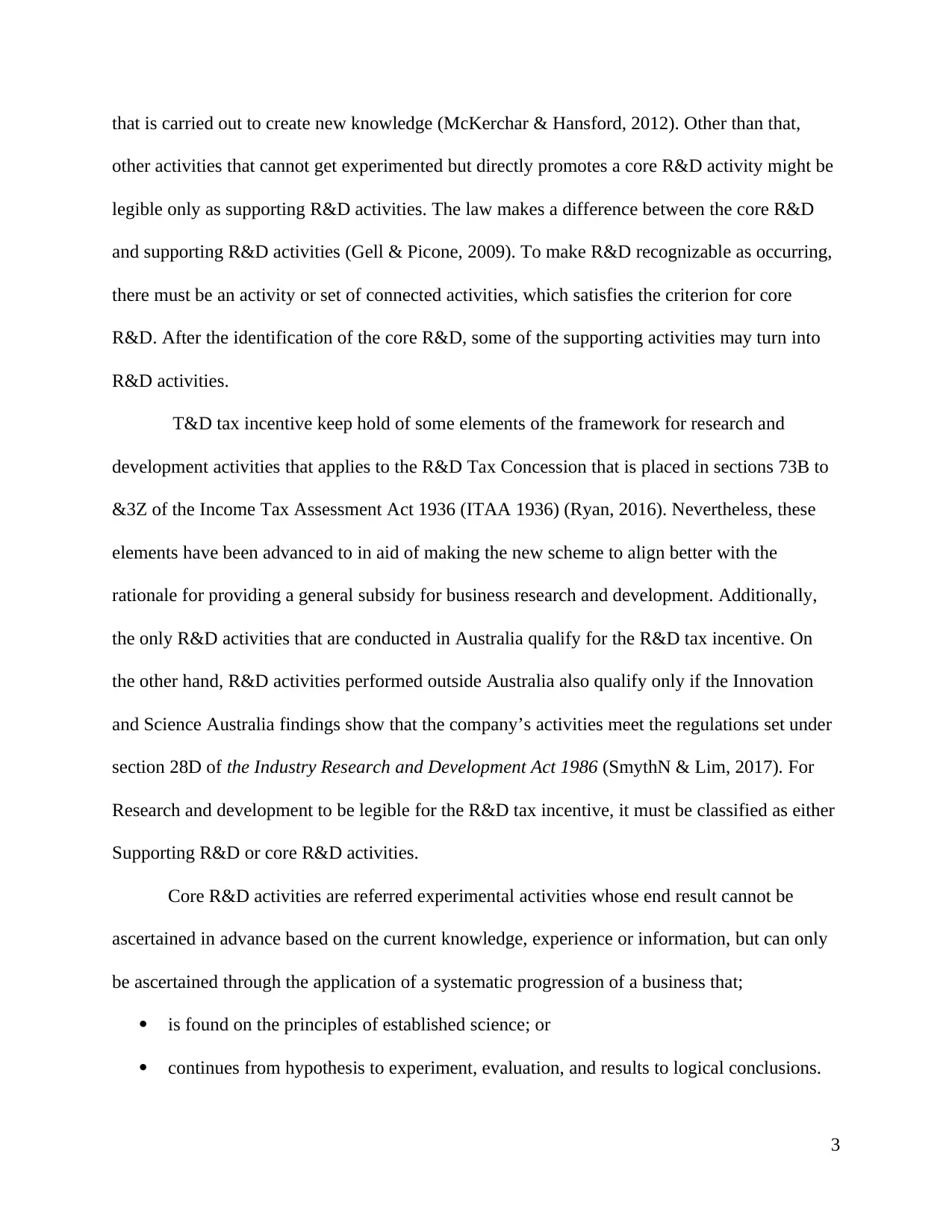
that is carried out to create new knowledge (McKerchar & Hansford, 2012). Other than that,
other activities that cannot get experimented but directly promotes a core R&D activity might be
legible only as supporting R&D activities. The law makes a difference between the core R&D
and supporting R&D activities (Gell & Picone, 2009). To make R&D recognizable as occurring,
there must be an activity or set of connected activities, which satisfies the criterion for core
R&D. After the identification of the core R&D, some of the supporting activities may turn into
R&D activities.
T&D tax incentive keep hold of some elements of the framework for research and
development activities that applies to the R&D Tax Concession that is placed in sections 73B to
&3Z of the Income Tax Assessment Act 1936 (ITAA 1936) (Ryan, 2016). Nevertheless, these
elements have been advanced to in aid of making the new scheme to align better with the
rationale for providing a general subsidy for business research and development. Additionally,
the only R&D activities that are conducted in Australia qualify for the R&D tax incentive. On
the other hand, R&D activities performed outside Australia also qualify only if the Innovation
and Science Australia findings show that the company’s activities meet the regulations set under
section 28D of the Industry Research and Development Act 1986 (SmythN & Lim, 2017). For
Research and development to be legible for the R&D tax incentive, it must be classified as either
Supporting R&D or core R&D activities.
Core R&D activities are referred experimental activities whose end result cannot be
ascertained in advance based on the current knowledge, experience or information, but can only
be ascertained through the application of a systematic progression of a business that;
is found on the principles of established science; or
continues from hypothesis to experiment, evaluation, and results to logical conclusions.
3
other activities that cannot get experimented but directly promotes a core R&D activity might be
legible only as supporting R&D activities. The law makes a difference between the core R&D
and supporting R&D activities (Gell & Picone, 2009). To make R&D recognizable as occurring,
there must be an activity or set of connected activities, which satisfies the criterion for core
R&D. After the identification of the core R&D, some of the supporting activities may turn into
R&D activities.
T&D tax incentive keep hold of some elements of the framework for research and
development activities that applies to the R&D Tax Concession that is placed in sections 73B to
&3Z of the Income Tax Assessment Act 1936 (ITAA 1936) (Ryan, 2016). Nevertheless, these
elements have been advanced to in aid of making the new scheme to align better with the
rationale for providing a general subsidy for business research and development. Additionally,
the only R&D activities that are conducted in Australia qualify for the R&D tax incentive. On
the other hand, R&D activities performed outside Australia also qualify only if the Innovation
and Science Australia findings show that the company’s activities meet the regulations set under
section 28D of the Industry Research and Development Act 1986 (SmythN & Lim, 2017). For
Research and development to be legible for the R&D tax incentive, it must be classified as either
Supporting R&D or core R&D activities.
Core R&D activities are referred experimental activities whose end result cannot be
ascertained in advance based on the current knowledge, experience or information, but can only
be ascertained through the application of a systematic progression of a business that;
is found on the principles of established science; or
continues from hypothesis to experiment, evaluation, and results to logical conclusions.
3
⊘ This is a preview!⊘
Do you want full access?
Subscribe today to unlock all pages.

Trusted by 1+ million students worldwide
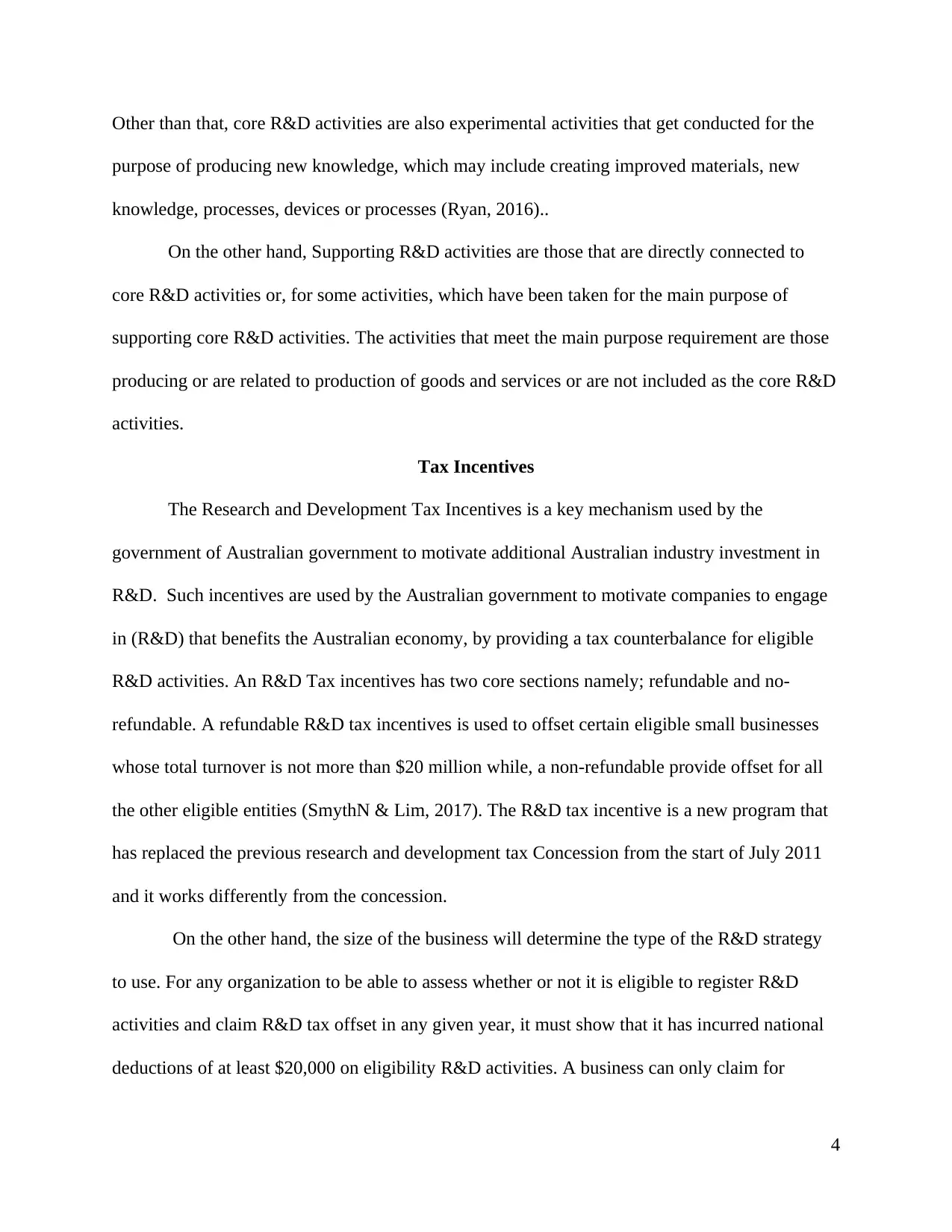
Other than that, core R&D activities are also experimental activities that get conducted for the
purpose of producing new knowledge, which may include creating improved materials, new
knowledge, processes, devices or processes (Ryan, 2016)..
On the other hand, Supporting R&D activities are those that are directly connected to
core R&D activities or, for some activities, which have been taken for the main purpose of
supporting core R&D activities. The activities that meet the main purpose requirement are those
producing or are related to production of goods and services or are not included as the core R&D
activities.
Tax Incentives
The Research and Development Tax Incentives is a key mechanism used by the
government of Australian government to motivate additional Australian industry investment in
R&D. Such incentives are used by the Australian government to motivate companies to engage
in (R&D) that benefits the Australian economy, by providing a tax counterbalance for eligible
R&D activities. An R&D Tax incentives has two core sections namely; refundable and no-
refundable. A refundable R&D tax incentives is used to offset certain eligible small businesses
whose total turnover is not more than $20 million while, a non-refundable provide offset for all
the other eligible entities (SmythN & Lim, 2017). The R&D tax incentive is a new program that
has replaced the previous research and development tax Concession from the start of July 2011
and it works differently from the concession.
On the other hand, the size of the business will determine the type of the R&D strategy
to use. For any organization to be able to assess whether or not it is eligible to register R&D
activities and claim R&D tax offset in any given year, it must show that it has incurred national
deductions of at least $20,000 on eligibility R&D activities. A business can only claim for
4
purpose of producing new knowledge, which may include creating improved materials, new
knowledge, processes, devices or processes (Ryan, 2016)..
On the other hand, Supporting R&D activities are those that are directly connected to
core R&D activities or, for some activities, which have been taken for the main purpose of
supporting core R&D activities. The activities that meet the main purpose requirement are those
producing or are related to production of goods and services or are not included as the core R&D
activities.
Tax Incentives
The Research and Development Tax Incentives is a key mechanism used by the
government of Australian government to motivate additional Australian industry investment in
R&D. Such incentives are used by the Australian government to motivate companies to engage
in (R&D) that benefits the Australian economy, by providing a tax counterbalance for eligible
R&D activities. An R&D Tax incentives has two core sections namely; refundable and no-
refundable. A refundable R&D tax incentives is used to offset certain eligible small businesses
whose total turnover is not more than $20 million while, a non-refundable provide offset for all
the other eligible entities (SmythN & Lim, 2017). The R&D tax incentive is a new program that
has replaced the previous research and development tax Concession from the start of July 2011
and it works differently from the concession.
On the other hand, the size of the business will determine the type of the R&D strategy
to use. For any organization to be able to assess whether or not it is eligible to register R&D
activities and claim R&D tax offset in any given year, it must show that it has incurred national
deductions of at least $20,000 on eligibility R&D activities. A business can only claim for
4
Paraphrase This Document
Need a fresh take? Get an instant paraphrase of this document with our AI Paraphraser
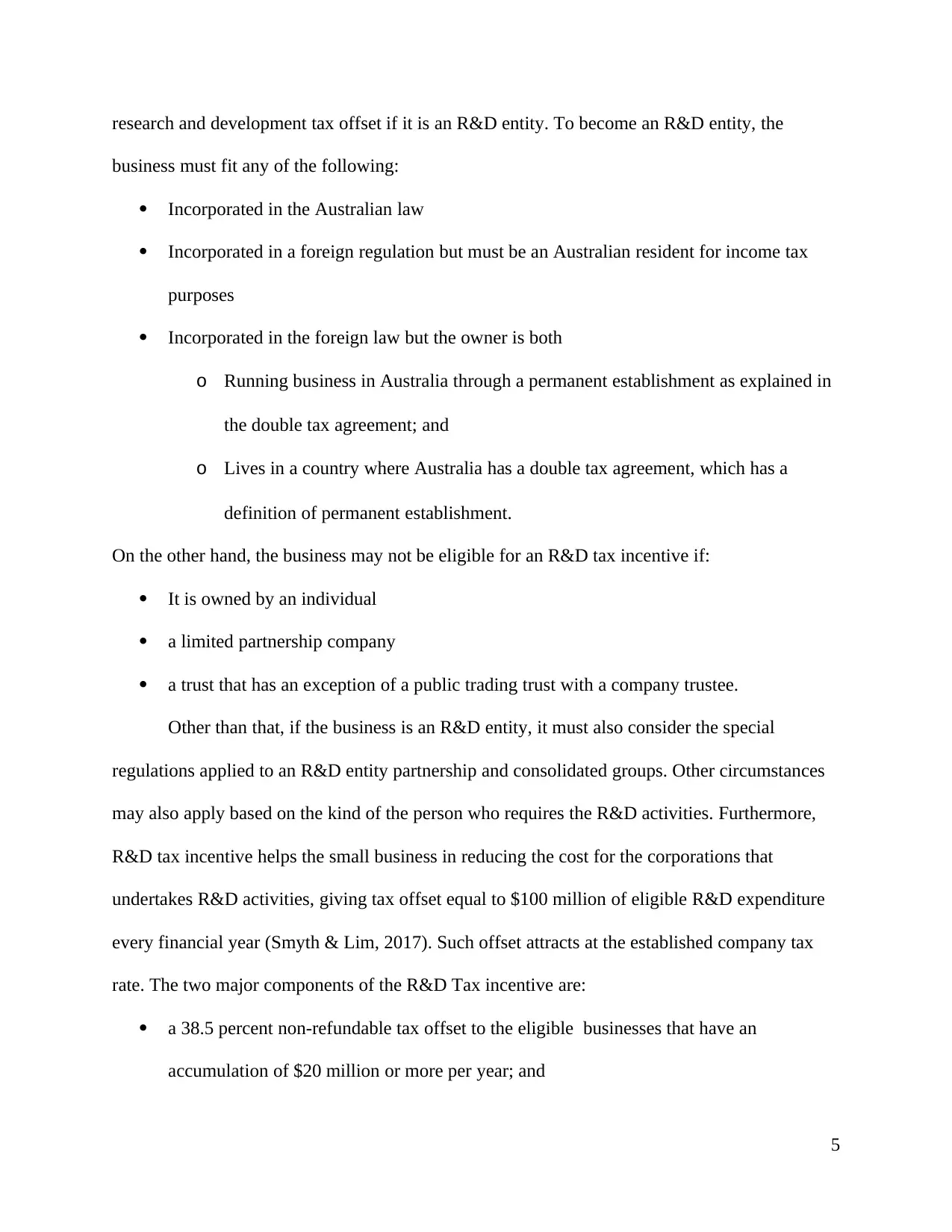
research and development tax offset if it is an R&D entity. To become an R&D entity, the
business must fit any of the following:
Incorporated in the Australian law
Incorporated in a foreign regulation but must be an Australian resident for income tax
purposes
Incorporated in the foreign law but the owner is both
o Running business in Australia through a permanent establishment as explained in
the double tax agreement; and
o Lives in a country where Australia has a double tax agreement, which has a
definition of permanent establishment.
On the other hand, the business may not be eligible for an R&D tax incentive if:
It is owned by an individual
a limited partnership company
a trust that has an exception of a public trading trust with a company trustee.
Other than that, if the business is an R&D entity, it must also consider the special
regulations applied to an R&D entity partnership and consolidated groups. Other circumstances
may also apply based on the kind of the person who requires the R&D activities. Furthermore,
R&D tax incentive helps the small business in reducing the cost for the corporations that
undertakes R&D activities, giving tax offset equal to $100 million of eligible R&D expenditure
every financial year (Smyth & Lim, 2017). Such offset attracts at the established company tax
rate. The two major components of the R&D Tax incentive are:
a 38.5 percent non-refundable tax offset to the eligible businesses that have an
accumulation of $20 million or more per year; and
5
business must fit any of the following:
Incorporated in the Australian law
Incorporated in a foreign regulation but must be an Australian resident for income tax
purposes
Incorporated in the foreign law but the owner is both
o Running business in Australia through a permanent establishment as explained in
the double tax agreement; and
o Lives in a country where Australia has a double tax agreement, which has a
definition of permanent establishment.
On the other hand, the business may not be eligible for an R&D tax incentive if:
It is owned by an individual
a limited partnership company
a trust that has an exception of a public trading trust with a company trustee.
Other than that, if the business is an R&D entity, it must also consider the special
regulations applied to an R&D entity partnership and consolidated groups. Other circumstances
may also apply based on the kind of the person who requires the R&D activities. Furthermore,
R&D tax incentive helps the small business in reducing the cost for the corporations that
undertakes R&D activities, giving tax offset equal to $100 million of eligible R&D expenditure
every financial year (Smyth & Lim, 2017). Such offset attracts at the established company tax
rate. The two major components of the R&D Tax incentive are:
a 38.5 percent non-refundable tax offset to the eligible businesses that have an
accumulation of $20 million or more per year; and
5
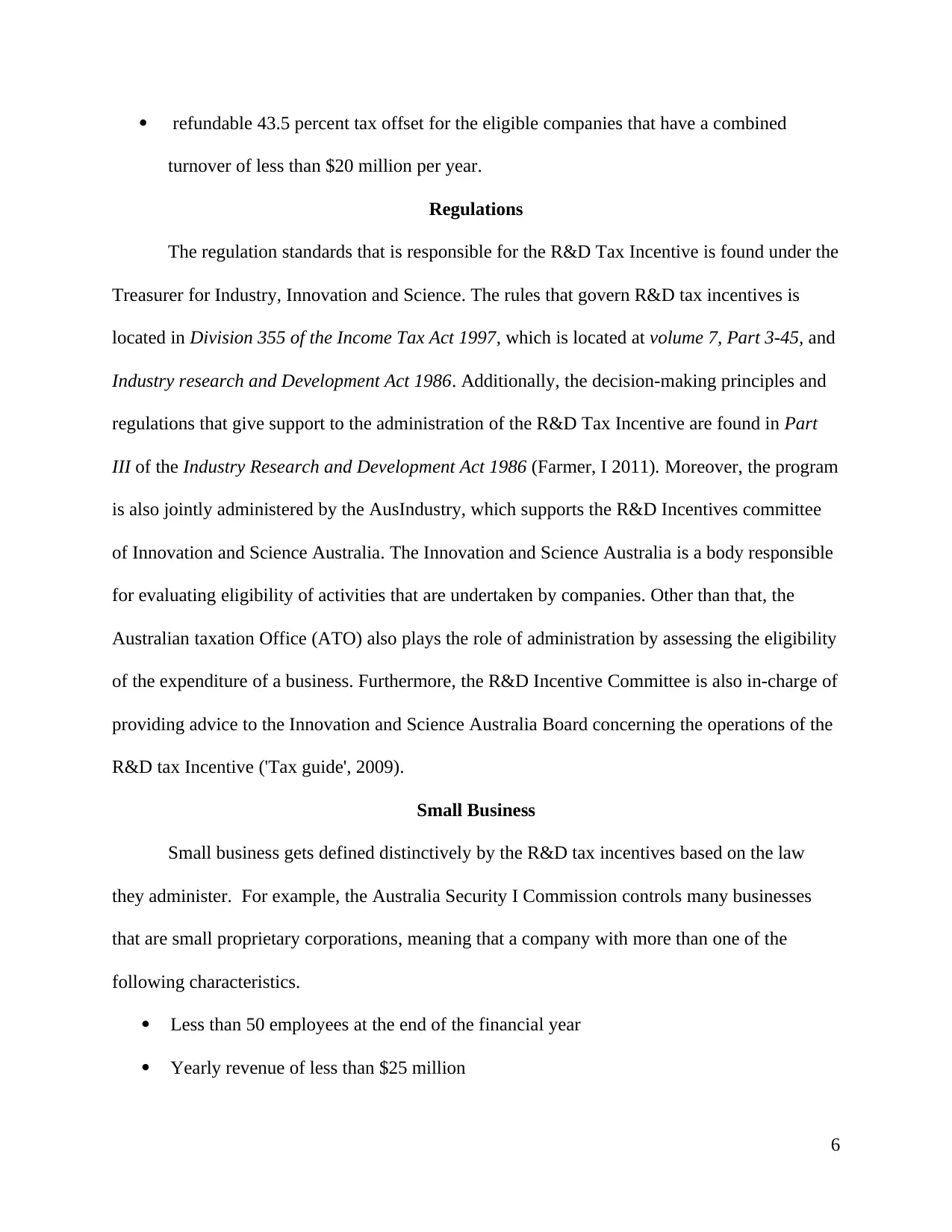
refundable 43.5 percent tax offset for the eligible companies that have a combined
turnover of less than $20 million per year.
Regulations
The regulation standards that is responsible for the R&D Tax Incentive is found under the
Treasurer for Industry, Innovation and Science. The rules that govern R&D tax incentives is
located in Division 355 of the Income Tax Act 1997, which is located at volume 7, Part 3-45, and
Industry research and Development Act 1986. Additionally, the decision-making principles and
regulations that give support to the administration of the R&D Tax Incentive are found in Part
III of the Industry Research and Development Act 1986 (Farmer, I 2011). Moreover, the program
is also jointly administered by the AusIndustry, which supports the R&D Incentives committee
of Innovation and Science Australia. The Innovation and Science Australia is a body responsible
for evaluating eligibility of activities that are undertaken by companies. Other than that, the
Australian taxation Office (ATO) also plays the role of administration by assessing the eligibility
of the expenditure of a business. Furthermore, the R&D Incentive Committee is also in-charge of
providing advice to the Innovation and Science Australia Board concerning the operations of the
R&D tax Incentive ('Tax guide', 2009).
Small Business
Small business gets defined distinctively by the R&D tax incentives based on the law
they administer. For example, the Australia Security I Commission controls many businesses
that are small proprietary corporations, meaning that a company with more than one of the
following characteristics.
Less than 50 employees at the end of the financial year
Yearly revenue of less than $25 million
6
turnover of less than $20 million per year.
Regulations
The regulation standards that is responsible for the R&D Tax Incentive is found under the
Treasurer for Industry, Innovation and Science. The rules that govern R&D tax incentives is
located in Division 355 of the Income Tax Act 1997, which is located at volume 7, Part 3-45, and
Industry research and Development Act 1986. Additionally, the decision-making principles and
regulations that give support to the administration of the R&D Tax Incentive are found in Part
III of the Industry Research and Development Act 1986 (Farmer, I 2011). Moreover, the program
is also jointly administered by the AusIndustry, which supports the R&D Incentives committee
of Innovation and Science Australia. The Innovation and Science Australia is a body responsible
for evaluating eligibility of activities that are undertaken by companies. Other than that, the
Australian taxation Office (ATO) also plays the role of administration by assessing the eligibility
of the expenditure of a business. Furthermore, the R&D Incentive Committee is also in-charge of
providing advice to the Innovation and Science Australia Board concerning the operations of the
R&D tax Incentive ('Tax guide', 2009).
Small Business
Small business gets defined distinctively by the R&D tax incentives based on the law
they administer. For example, the Australia Security I Commission controls many businesses
that are small proprietary corporations, meaning that a company with more than one of the
following characteristics.
Less than 50 employees at the end of the financial year
Yearly revenue of less than $25 million
6
⊘ This is a preview!⊘
Do you want full access?
Subscribe today to unlock all pages.

Trusted by 1+ million students worldwide
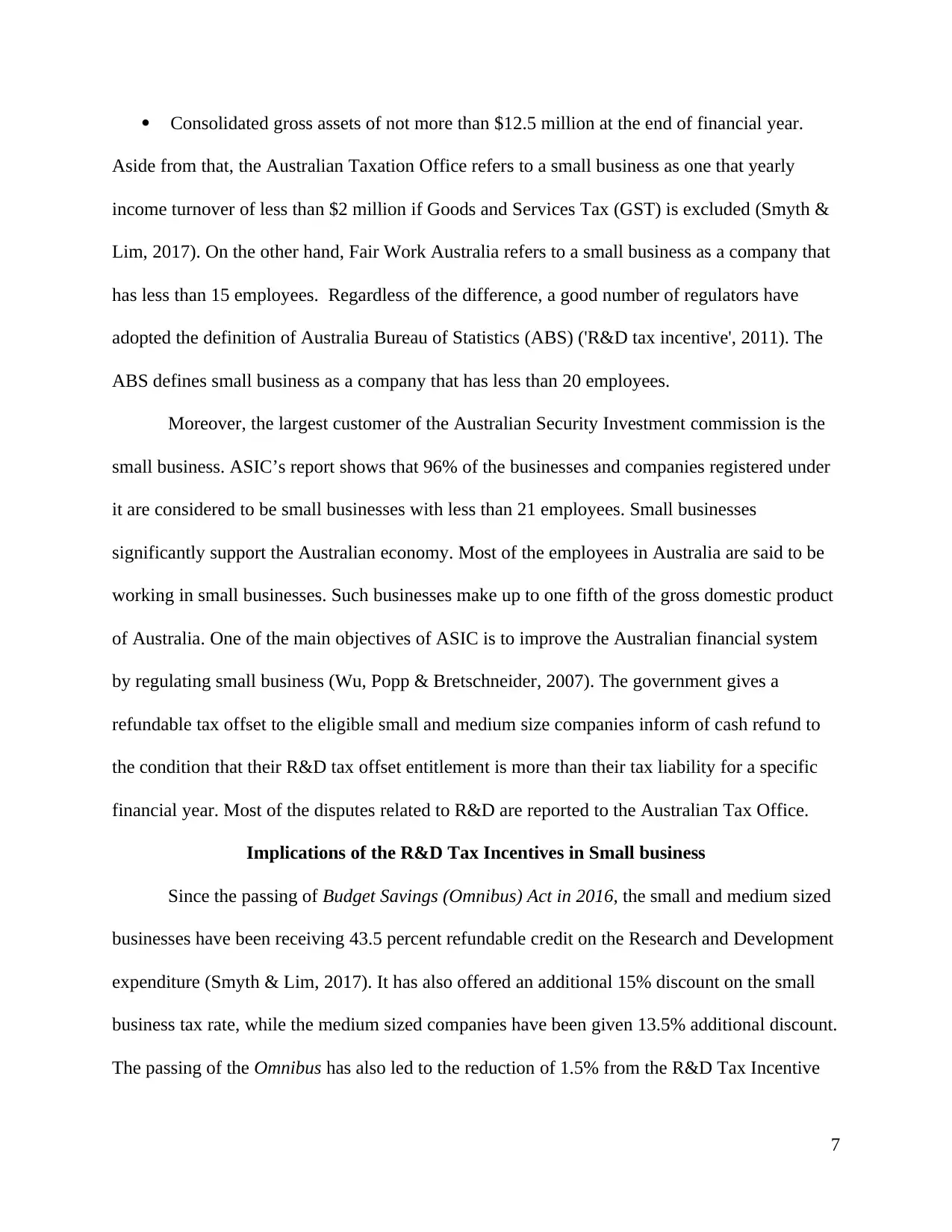
Consolidated gross assets of not more than $12.5 million at the end of financial year.
Aside from that, the Australian Taxation Office refers to a small business as one that yearly
income turnover of less than $2 million if Goods and Services Tax (GST) is excluded (Smyth &
Lim, 2017). On the other hand, Fair Work Australia refers to a small business as a company that
has less than 15 employees. Regardless of the difference, a good number of regulators have
adopted the definition of Australia Bureau of Statistics (ABS) ('R&D tax incentive', 2011). The
ABS defines small business as a company that has less than 20 employees.
Moreover, the largest customer of the Australian Security Investment commission is the
small business. ASIC’s report shows that 96% of the businesses and companies registered under
it are considered to be small businesses with less than 21 employees. Small businesses
significantly support the Australian economy. Most of the employees in Australia are said to be
working in small businesses. Such businesses make up to one fifth of the gross domestic product
of Australia. One of the main objectives of ASIC is to improve the Australian financial system
by regulating small business (Wu, Popp & Bretschneider, 2007). The government gives a
refundable tax offset to the eligible small and medium size companies inform of cash refund to
the condition that their R&D tax offset entitlement is more than their tax liability for a specific
financial year. Most of the disputes related to R&D are reported to the Australian Tax Office.
Implications of the R&D Tax Incentives in Small business
Since the passing of Budget Savings (Omnibus) Act in 2016, the small and medium sized
businesses have been receiving 43.5 percent refundable credit on the Research and Development
expenditure (Smyth & Lim, 2017). It has also offered an additional 15% discount on the small
business tax rate, while the medium sized companies have been given 13.5% additional discount.
The passing of the Omnibus has also led to the reduction of 1.5% from the R&D Tax Incentive
7
Aside from that, the Australian Taxation Office refers to a small business as one that yearly
income turnover of less than $2 million if Goods and Services Tax (GST) is excluded (Smyth &
Lim, 2017). On the other hand, Fair Work Australia refers to a small business as a company that
has less than 15 employees. Regardless of the difference, a good number of regulators have
adopted the definition of Australia Bureau of Statistics (ABS) ('R&D tax incentive', 2011). The
ABS defines small business as a company that has less than 20 employees.
Moreover, the largest customer of the Australian Security Investment commission is the
small business. ASIC’s report shows that 96% of the businesses and companies registered under
it are considered to be small businesses with less than 21 employees. Small businesses
significantly support the Australian economy. Most of the employees in Australia are said to be
working in small businesses. Such businesses make up to one fifth of the gross domestic product
of Australia. One of the main objectives of ASIC is to improve the Australian financial system
by regulating small business (Wu, Popp & Bretschneider, 2007). The government gives a
refundable tax offset to the eligible small and medium size companies inform of cash refund to
the condition that their R&D tax offset entitlement is more than their tax liability for a specific
financial year. Most of the disputes related to R&D are reported to the Australian Tax Office.
Implications of the R&D Tax Incentives in Small business
Since the passing of Budget Savings (Omnibus) Act in 2016, the small and medium sized
businesses have been receiving 43.5 percent refundable credit on the Research and Development
expenditure (Smyth & Lim, 2017). It has also offered an additional 15% discount on the small
business tax rate, while the medium sized companies have been given 13.5% additional discount.
The passing of the Omnibus has also led to the reduction of 1.5% from the R&D Tax Incentive
7
Paraphrase This Document
Need a fresh take? Get an instant paraphrase of this document with our AI Paraphraser
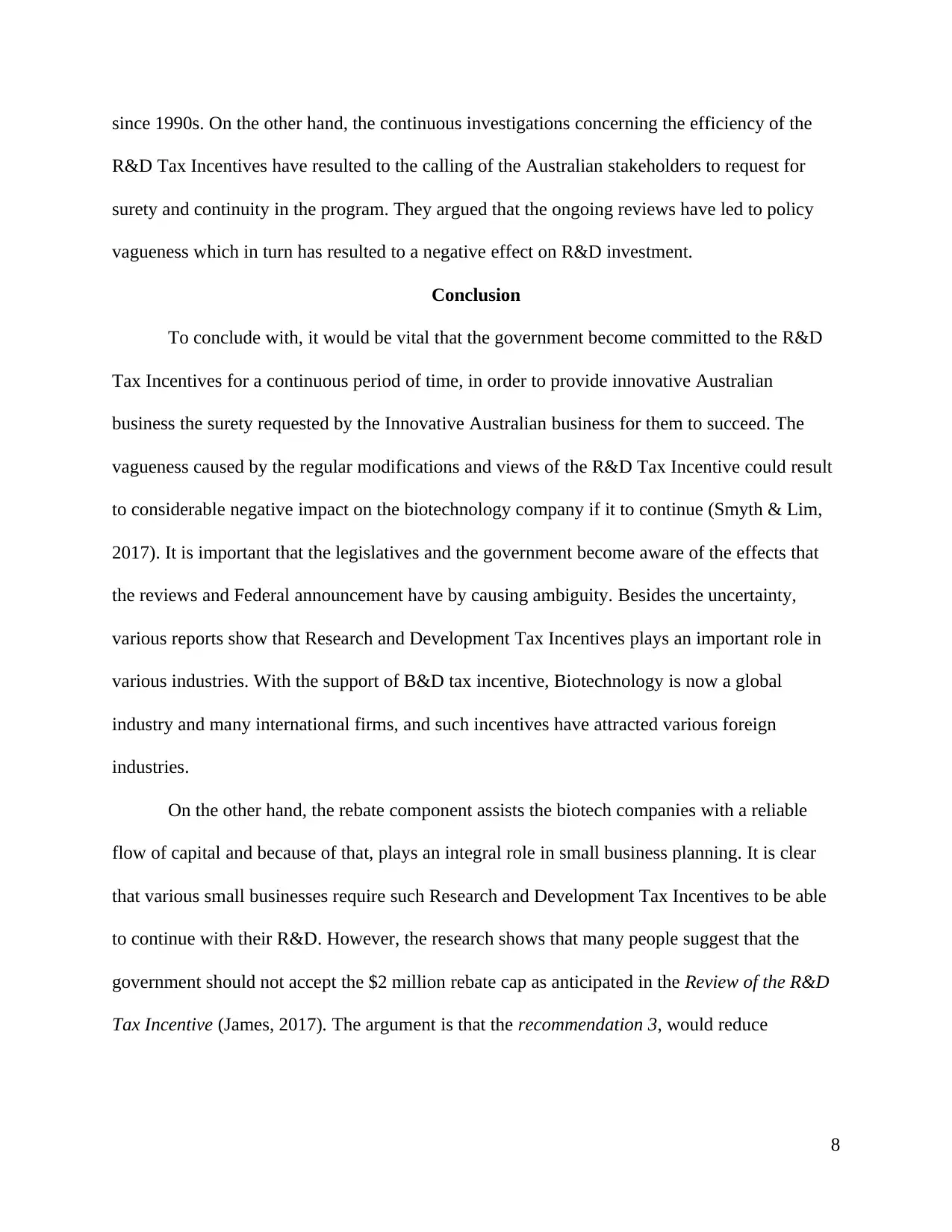
since 1990s. On the other hand, the continuous investigations concerning the efficiency of the
R&D Tax Incentives have resulted to the calling of the Australian stakeholders to request for
surety and continuity in the program. They argued that the ongoing reviews have led to policy
vagueness which in turn has resulted to a negative effect on R&D investment.
Conclusion
To conclude with, it would be vital that the government become committed to the R&D
Tax Incentives for a continuous period of time, in order to provide innovative Australian
business the surety requested by the Innovative Australian business for them to succeed. The
vagueness caused by the regular modifications and views of the R&D Tax Incentive could result
to considerable negative impact on the biotechnology company if it to continue (Smyth & Lim,
2017). It is important that the legislatives and the government become aware of the effects that
the reviews and Federal announcement have by causing ambiguity. Besides the uncertainty,
various reports show that Research and Development Tax Incentives plays an important role in
various industries. With the support of B&D tax incentive, Biotechnology is now a global
industry and many international firms, and such incentives have attracted various foreign
industries.
On the other hand, the rebate component assists the biotech companies with a reliable
flow of capital and because of that, plays an integral role in small business planning. It is clear
that various small businesses require such Research and Development Tax Incentives to be able
to continue with their R&D. However, the research shows that many people suggest that the
government should not accept the $2 million rebate cap as anticipated in the Review of the R&D
Tax Incentive (James, 2017). The argument is that the recommendation 3, would reduce
8
R&D Tax Incentives have resulted to the calling of the Australian stakeholders to request for
surety and continuity in the program. They argued that the ongoing reviews have led to policy
vagueness which in turn has resulted to a negative effect on R&D investment.
Conclusion
To conclude with, it would be vital that the government become committed to the R&D
Tax Incentives for a continuous period of time, in order to provide innovative Australian
business the surety requested by the Innovative Australian business for them to succeed. The
vagueness caused by the regular modifications and views of the R&D Tax Incentive could result
to considerable negative impact on the biotechnology company if it to continue (Smyth & Lim,
2017). It is important that the legislatives and the government become aware of the effects that
the reviews and Federal announcement have by causing ambiguity. Besides the uncertainty,
various reports show that Research and Development Tax Incentives plays an important role in
various industries. With the support of B&D tax incentive, Biotechnology is now a global
industry and many international firms, and such incentives have attracted various foreign
industries.
On the other hand, the rebate component assists the biotech companies with a reliable
flow of capital and because of that, plays an integral role in small business planning. It is clear
that various small businesses require such Research and Development Tax Incentives to be able
to continue with their R&D. However, the research shows that many people suggest that the
government should not accept the $2 million rebate cap as anticipated in the Review of the R&D
Tax Incentive (James, 2017). The argument is that the recommendation 3, would reduce
8
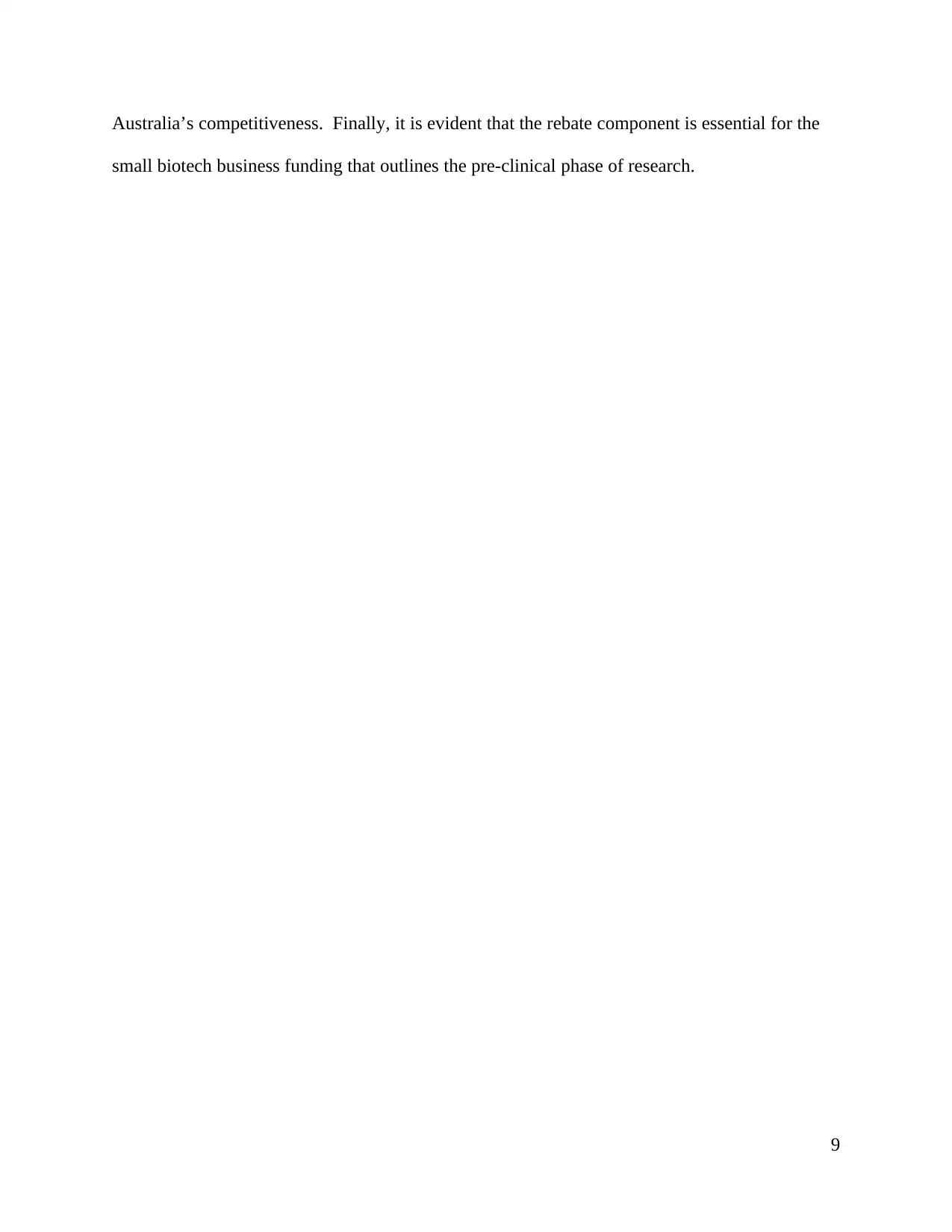
Australia’s competitiveness. Finally, it is evident that the rebate component is essential for the
small biotech business funding that outlines the pre-clinical phase of research.
9
small biotech business funding that outlines the pre-clinical phase of research.
9
⊘ This is a preview!⊘
Do you want full access?
Subscribe today to unlock all pages.

Trusted by 1+ million students worldwide
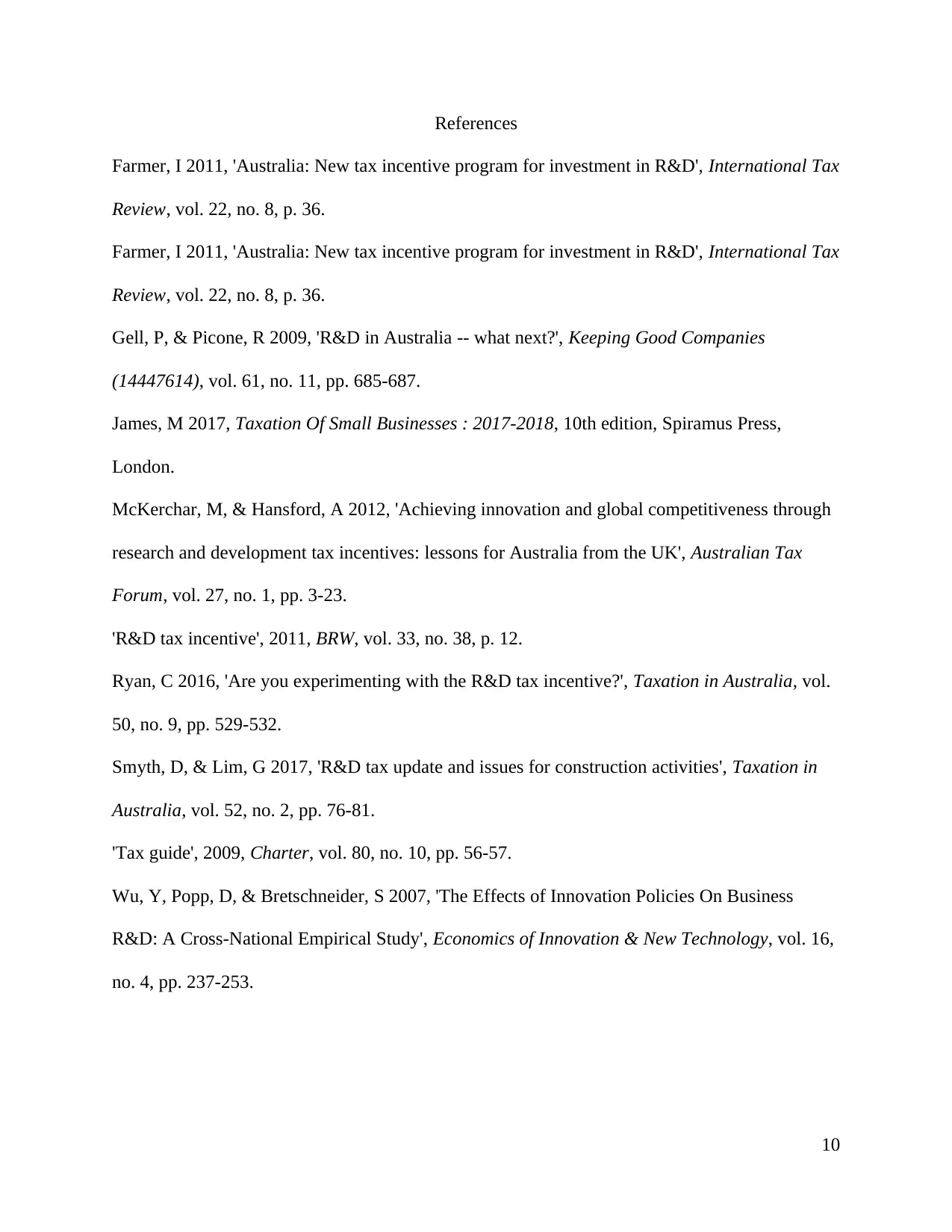
References
Farmer, I 2011, 'Australia: New tax incentive program for investment in R&D', International Tax
Review, vol. 22, no. 8, p. 36.
Farmer, I 2011, 'Australia: New tax incentive program for investment in R&D', International Tax
Review, vol. 22, no. 8, p. 36.
Gell, P, & Picone, R 2009, 'R&D in Australia -- what next?', Keeping Good Companies
(14447614), vol. 61, no. 11, pp. 685-687.
James, M 2017, Taxation Of Small Businesses : 2017-2018, 10th edition, Spiramus Press,
London.
McKerchar, M, & Hansford, A 2012, 'Achieving innovation and global competitiveness through
research and development tax incentives: lessons for Australia from the UK', Australian Tax
Forum, vol. 27, no. 1, pp. 3-23.
'R&D tax incentive', 2011, BRW, vol. 33, no. 38, p. 12.
Ryan, C 2016, 'Are you experimenting with the R&D tax incentive?', Taxation in Australia, vol.
50, no. 9, pp. 529-532.
Smyth, D, & Lim, G 2017, 'R&D tax update and issues for construction activities', Taxation in
Australia, vol. 52, no. 2, pp. 76-81.
'Tax guide', 2009, Charter, vol. 80, no. 10, pp. 56-57.
Wu, Y, Popp, D, & Bretschneider, S 2007, 'The Effects of Innovation Policies On Business
R&D: A Cross-National Empirical Study', Economics of Innovation & New Technology, vol. 16,
no. 4, pp. 237-253.
10
Farmer, I 2011, 'Australia: New tax incentive program for investment in R&D', International Tax
Review, vol. 22, no. 8, p. 36.
Farmer, I 2011, 'Australia: New tax incentive program for investment in R&D', International Tax
Review, vol. 22, no. 8, p. 36.
Gell, P, & Picone, R 2009, 'R&D in Australia -- what next?', Keeping Good Companies
(14447614), vol. 61, no. 11, pp. 685-687.
James, M 2017, Taxation Of Small Businesses : 2017-2018, 10th edition, Spiramus Press,
London.
McKerchar, M, & Hansford, A 2012, 'Achieving innovation and global competitiveness through
research and development tax incentives: lessons for Australia from the UK', Australian Tax
Forum, vol. 27, no. 1, pp. 3-23.
'R&D tax incentive', 2011, BRW, vol. 33, no. 38, p. 12.
Ryan, C 2016, 'Are you experimenting with the R&D tax incentive?', Taxation in Australia, vol.
50, no. 9, pp. 529-532.
Smyth, D, & Lim, G 2017, 'R&D tax update and issues for construction activities', Taxation in
Australia, vol. 52, no. 2, pp. 76-81.
'Tax guide', 2009, Charter, vol. 80, no. 10, pp. 56-57.
Wu, Y, Popp, D, & Bretschneider, S 2007, 'The Effects of Innovation Policies On Business
R&D: A Cross-National Empirical Study', Economics of Innovation & New Technology, vol. 16,
no. 4, pp. 237-253.
10
1 out of 10
Related Documents
Your All-in-One AI-Powered Toolkit for Academic Success.
+13062052269
info@desklib.com
Available 24*7 on WhatsApp / Email
![[object Object]](/_next/static/media/star-bottom.7253800d.svg)
Unlock your academic potential
Copyright © 2020–2025 A2Z Services. All Rights Reserved. Developed and managed by ZUCOL.





